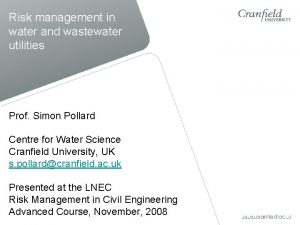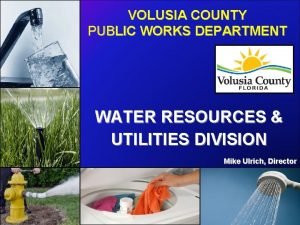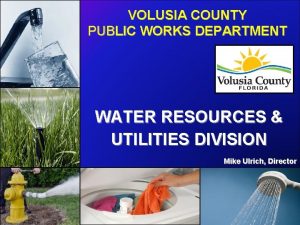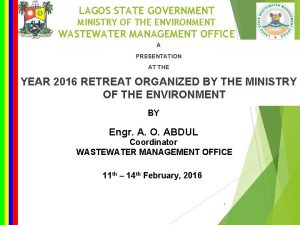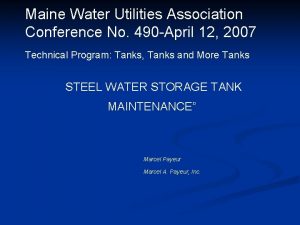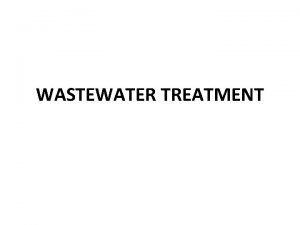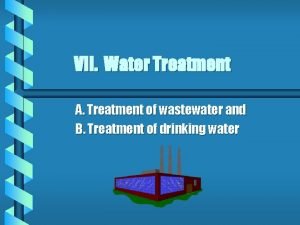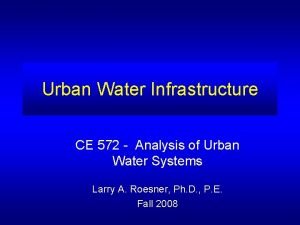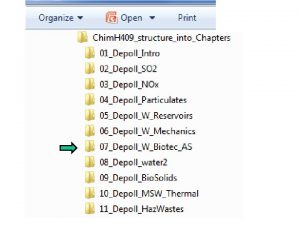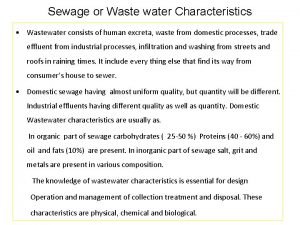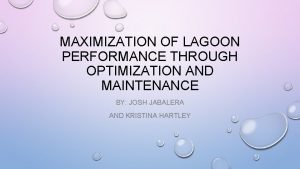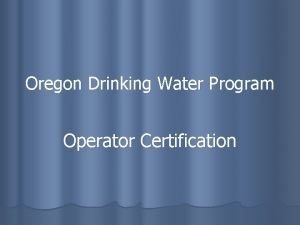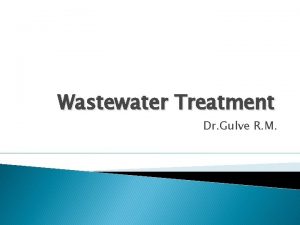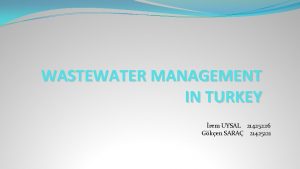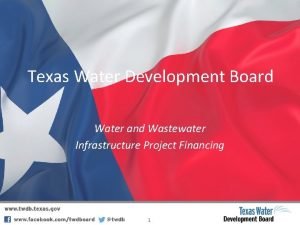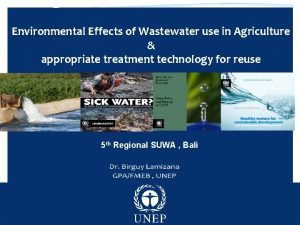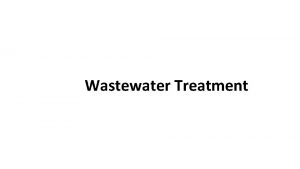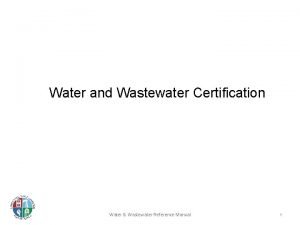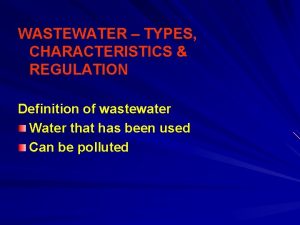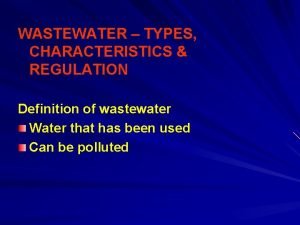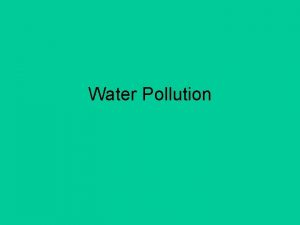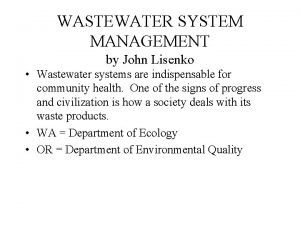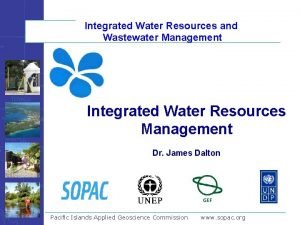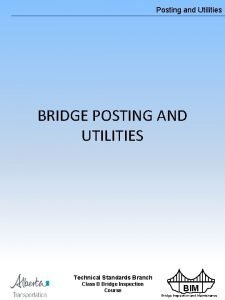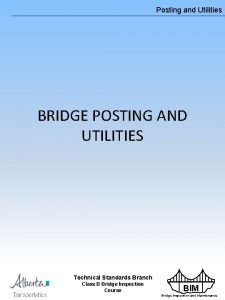Risk management in water and wastewater utilities Prof
























- Slides: 24

Risk management in water and wastewater utilities Prof. Simon Pollard Centre for Water Science Cranfield University, UK s. pollard@cranfield. ac. uk Presented at the LNEC Risk Management in Civil Engineering Advanced Course, November, 2008

Context • • Growth in enterprise risk management since 1990’s Paradox of ‘putting assets at risk to protect public health’ Nagging prevalence of water quality incidents Stakeholder society has meant a re-interpretation of the ‘licence to operate’ (confidence) • Risk, innovation and opportunity • Rediscover our sector’s ‘basic assumption’ (why we are in business) – the Bonn Charter

Safe drinking water - a public health service © United Water (Suez), Hoboken water service, US

Distribution of particle removals by 67 surface water treatment plants mlog 2. 7 -log 30 1. 96 -log frequency 25 1. 78 -log 20 15 Bad days and by-pass 10 5 0 0 1 log 10 (after Le. Chevallier & Norton 1995; Gale 2001) 2 3 4 removal for particles (>3 mm) 5 6

Values turn out to be critical

Capital investment A 2 stage investment process Shareholders (and others) invest in company Company invests in portfolio of projects In a perfectly competitive market the portfolio of projects achieves exactly the return demanded by shareholders and other sources of finance; i. e. no value is created (adapted from Srikanthan, 2007)

Business reality Shareholder’s risk/return line Increase return more than risk Return Reduced risk more than return X Start point Any strategy that moves below the line, reduces shareholder value Risk

The ‘well-being’ of assets Inspection interval (t. I) depends on: Current condition – condition assessment Rate of deterioration – time to failure Condition threshold - criticality Inspect Good Observ Condition ed Poor Pro ject ed ‘Condition threshold’ varies depends on criticality Remaining useful life (t. U) Assessment of residual life (tr) Time

Retain organisation redundancy if moving to ‘lean’ Healthy (assets, organisations, teams, individuals) The danger is one of becoming failure tolerant. This not only increases failures, but makes them acceptable. marginal Reduce costs, more efficient Before you go here, have you shared your appetite for risk? failed

Accidents and safety culture 20 -30% Technical factors Accident causation Metrics for managerial resilience • Safety ‘climate surveys’ • Upward appraisal on safety • Situational judgement interviews 80 -70% Human factors = Safety culture ~ 80% (after Flin, 2005) + Operator error ~ 20%

What Happened at Well 5, Walkerton, Ontario? · Heavy rains washed manure from barnyard into Well Farm by penetration of the shallow soil cover · Well 5 was being operated with a chlorine dose below 0. 5 mg/L, despite a requirement to keep chlorine residual above 0. 5 mg/L Well #5 chlorine residual = chlorine dose – chlorine demand · · Farm Manure contamination (i. e. chlorine demand) overwhelmed chlorine dose, eliminating any effective disinfection Chlorine residual was the only “real time” measure in place to detect organic contamination (Hrudey, 2006)

Widespread illness began to emerge on May 18, with ~20 children absent from school and 2 children admitted to Owen Sound Hospital, ~65 km away, with bloody diarrhea (Hrudey, 2006) May 2000 Walkerton, Ontario On May 19 a GI outbreak was evident in a retirement home, the Walkerton Hospital was overwhelmed with sick people and an investigation was launched by the local health unit suspecting a foodborne outbreak

Consequences • 7 people died from this outbreak • Mary Rose Raymond, a 2. 5 year old, died on Tuesday, May 23. She came from a nearby town to Walkerton for Mothers Day and drank only 1 glass of water • An estimated 2, 300 individuals were ill with gastroenteritis (half the town’s population) • 65 patients were hospitalized • 27 developed haemolytic uremic syndrome (HUS) • 52 % of HUS cases were between 1 and 4 yrs • There is continuing illness in Walkerton today

How could this have happened in an affluent country? Latent and active flaws lie dormant, or “if you don’t actively manage risk, it doesn’t go away, it just builds up”. (after Reason, 2000)

Class Processes Core Strategic risk planning (SRP) Establishing risk acceptance criteria (ERAC) Risk analysis (RA) Risk based decision making and review (RBDM) Improving Risk response (RR) Risk monitoring (RM) Integrating risk management (IRM) Supporting Supply chain risk management (SCRM) Change risk management (CRM) Long-term Education and training in risk management (E&T) Risk knowledge management (RKM) Risk knowledge management and supply chain risk management How good are we, really, at preventatively managing risk? (Mac. Gillivray et al. , 2007 a, b)

The learning organisation ‘Lessons Learnt’ knowledge base Data Evidence Observation, reflection, and analysis Information Knowledge Organisational learning input Justification of decisions simulations/ analyses experiments tests & observations monitoring operations benchmarking Decision making

Getting the risk culture, Getting the culture right Stories Symbols • Cataloguing major • Risk management logo incidents from the past • Management involvement in • Demonstrating the value of risk management • Graphics/pictures • Risks taken that paid off Rituals & routines • High quality staff released to the project • Promotions on return to main business • Risk becomes ‘business as usual’ Control systems • Training programme for operational staff • Awareness programme or company wide IT system • No blame attributed to reported incidents or near misses (after Johnson, 1992; Content, 2005) incident response • Cleanliness of assets • Management performance measured Risk culture • Open risk reporting • Proactive approach to risk Power structure • Reporting to a CEO led • Risk taking and its rewards • ‘ 7 habits’ of good risk management • Explaining ‘why’ manage risk steering group • Decisions not solely costbased • Dissenting voices heard and deference to expertise Organisational structure • Specialist risk team • Group risk manager • ‘Getting started’ on the risk management journey ‘Cultural items’

Opportunities Safety culture: factor of 5 -10 improvement demonstrated Loss (€) ☺☺ €€€€ ☺ Risk management culture: additional factor of 3 -5 believed € Risk mature, self learning organisations 0 5 Implementation (years) 10

Lessons from safety cultures • Contributory preconditions: - A combination of factors, each of which would be unlikely, singly, to defeat the system. • Incubation period: - A period of time between the first fault initiation and the failure during which time communication problems and noise can blend with signals to mask warnings. - Concealed faults, incidents or partially understood events build up in a way at odds with existing beliefs and norms. • Precipitating event - A catalyst without which the event would not occur at that time and location.

Can the water sector become a high reliability sector? Four key themes: (i) preventing harm to people, property or the environment; (ii) operating core processes at the required capacity - this time, next time and every time; (iii) minimizing the number of errors per unit of activity; (iv) consistently meeting social and political demands for performance – leadership and committment.

Future focus Risk management process Strategic risk planning Establishing risk acceptance criteria Risk analysis Risk based decision making and review Risk response Risk monitoring and feedback Integrating risk management Supply chain risk management Change management Education and training in risk management Risk knowledge management Risk capability maturity level 1 2 3 4 5

Summary • Risk – integrated, holistic and concerned with opportunities, whilst not losing sight of the ‘basic assumption’ – public health protection • Vigilance is a key ‘cultural item’ • Managing risk knowledge is critical to becoming a learning, high reliability organisation • The new IWA Bonn Network as one vehicle to assist this – a one-stop shop, focused on better risk management for safe drinking water

Conclusion “Risk analysis tools, risk management frameworks, risk champions, risk matrices and risk committees are important organisational commitments … … but alone, they are not enough to secure a risk management culture within an organisation”.

References Pollard, S. , et al. (2007) Risk analysis strategies for credible and defensible utility decisions, Awwa Research Foundation Research Report 91168, Denver, CO, Ref 1 P-3. 25 C-91168 -02/07 -NH, 88 pp. B. H. Mac. Gillivray, J. V. Sharp, J. E. Strutt, P. D. Hamilton and S. J. T Pollard (2007) Benchmarking risk management within the international water utility sector. Part II: a survey of eight water utilities, J. Risk Research 10(1): 105 -123 Pollard, S. J. T. (ed. ) (2008) Risk management for water and wastewater utilities, IWA Publishing, London, 175 pp.
 Risk management for water and wastewater utilities
Risk management for water and wastewater utilities Water and water and water water
Water and water and water water Volusia county water resources and utilities
Volusia county water resources and utilities Volusia county utilities
Volusia county utilities Market risk credit risk operational risk
Market risk credit risk operational risk Lagos state wastewater management office
Lagos state wastewater management office Maine water utilities association
Maine water utilities association Fiduciary investment risk management association
Fiduciary investment risk management association Risk map
Risk map Wastewater treatment purpose
Wastewater treatment purpose Characteristics of aquaculture
Characteristics of aquaculture Wastewater treatment process primary secondary tertiary
Wastewater treatment process primary secondary tertiary Wastewater distribution system
Wastewater distribution system Typical composition of untreated domestic wastewater
Typical composition of untreated domestic wastewater Physical characteristics of wastewater
Physical characteristics of wastewater Optimize wastewater lagoon
Optimize wastewater lagoon Ashbridges bay treatment plant
Ashbridges bay treatment plant Oregon drinking water program
Oregon drinking water program Peak flow average
Peak flow average Municipal wastewater treatment
Municipal wastewater treatment Agricultural wastewater treatment technologies
Agricultural wastewater treatment technologies Anaerobic wastewater treatment
Anaerobic wastewater treatment Wastewater infrastructure design in texas
Wastewater infrastructure design in texas Sacramento regional wastewater treatment plant
Sacramento regional wastewater treatment plant Agricultural wastewater treatment technologies
Agricultural wastewater treatment technologies
